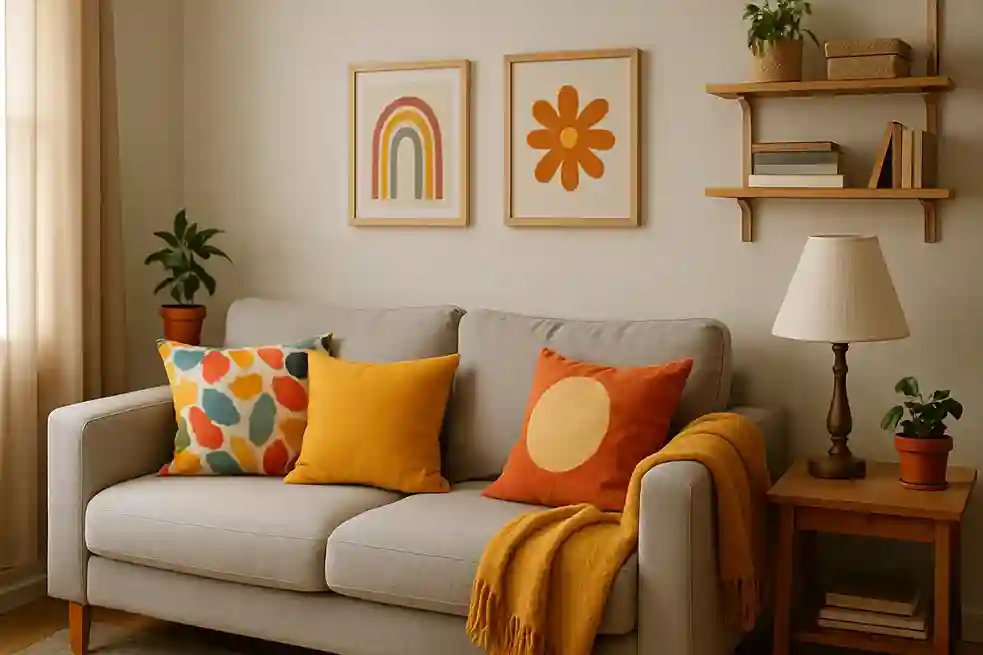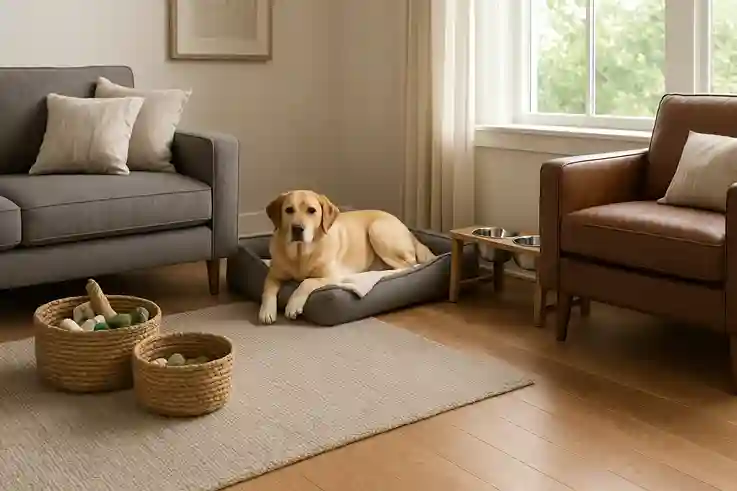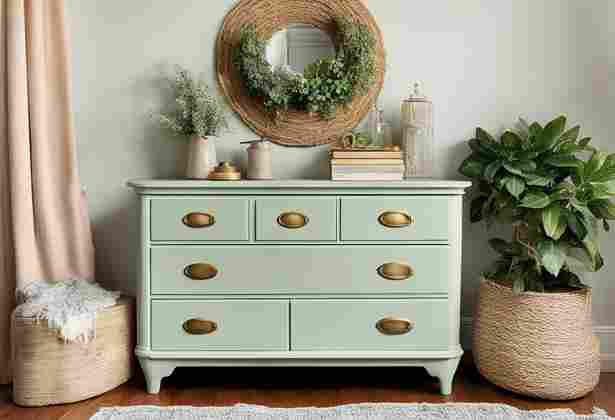Affordable Home Decor for a Happy Home
Affordable home decor creates a happy home—no matter your space, budget, or style. You don’t need designer furniture or expensive pieces to feel good in your space. What matters most is how your home makes you feel when you walk through the door.
Decor is emotional, not just visual. A cozy blanket can calm you. A gallery wall of personal photos can lift your mood. Even something as simple as rearranging furniture can spark new energy. Your home is more than four walls—it’s your reset space, your comfort zone, your personal sanctuary.
The good news? You don’t have to spend thousands to create that feeling. In this blog, you’ll find practical, affordable home decor tips to help you turn any room into a space that supports your happiness.
We’ll walk through simple updates you can make in the living room, bedroom, kitchen, and even small nooks—for under $200 per room. These tips work whether you rent, own, or share your home. The goal is joy, not perfection.
Affordable Home Decor Starts with Mindset
When you think about affordable home decor, it’s easy to focus on what you need to buy. But the truth is, your mindset matters more than your shopping list. A happy home doesn’t begin with price tags—it starts with how your space supports your daily life.
Why Happiness Matters More Than Perfection
Perfect homes look good in photos. Happy homes feel good in real life. Chasing a flawless aesthetic often leads to frustration and overspending. Instead of aiming for a picture-perfect space, aim for one that reflects you—your values, habits, and personality.
Decor choices that support comfort, function, and emotional warmth are always better than trendy items that don’t fit your life. When your space feels peaceful, organized, and intentional, it actually makes you happier to be in it—even if nothing in the room is new.
Shift from “Buy More” to “Use Better”
You don’t always need more stuff. Often, you need to see your space differently. Move your favorite chair to a sunny corner. Repurpose a scarf as a table runner. Use an old frame for new artwork. These small changes can be deeply satisfying and completely free.
This shift—valuing creativity over consumption—empowers you to work with what you have before buying anything new. It also keeps you grounded in what really brings joy, not what the next algorithm suggests you buy.
The Joy of Intentional Design (Not Expensive Design)
Intentional decor is about choices, not cost. It’s lighting a candle at dinner, even if you’re eating leftovers. It’s placing a family photo where you’ll see it every morning. It’s choosing calming colors for your bedroom because your rest matters.
You don’t need a designer. You need a reason for each item you keep, use, or display. That’s the mindset that makes affordable home decor truly powerful—and deeply personal.
Affordable Home Decor for Every Kind of Home
Whether you live in a house, apartment, dorm, or studio, affordable home decor can make your space feel truly special. Size, ownership, or location don’t limit your ability to create beauty and comfort. What matters is how you use what you have—creatively and intentionally.
House, Apartment, or Studio—Every Space Has Potential
You don’t need a huge living room or a designer kitchen to have a home you love. Small spaces can feel cozy and styled. Large rooms can be made warm and welcoming without major renovations.
Studio dwellers might focus on multi-use furniture and visual separation of spaces. Apartment renters can decorate with removable solutions like peel-and-stick wallpaper, floating shelves, and lightweight textiles. Homeowners on a budget might tackle one zone at a time—like a reading corner or kitchen counter.
The key is this: every space has decorating potential when viewed through the lens of function and joy.
Small Changes That Feel Big
Some of the most impactful changes don’t require buying anything at all. Here are three upgrades that work in any home:
- Rearranging: Move furniture to create better flow or focal points. Try angling a chair or swapping two rugs.
- Cleaning and Decluttering: A sparkling surface and clear counters instantly boost energy and visual calm.
- Lighting: Add a lamp, switch to warmer bulbs, or open the blinds—light changes everything.
These updates cost little or nothing, but they create a noticeable shift in how you feel at home.
Don’t Wait for “Someday”—Start with What Brings Joy Now
It’s easy to say, “I’ll decorate when I move,” or “I’ll fix it when I can afford new furniture.” But happiness shouldn’t be delayed. Start with small wins—arrange a shelf with objects that make you smile, light a candle in the evening, or hang a print that means something to you.
You don’t need to wait for perfect conditions. Affordable home decor is about doing what you can, with what you have, right now.
Room Makeovers Under $200: Realistic Ideas That Work
You don’t need a full renovation budget to breathe new life into your home. With just $200 or less, you can give each room a fresh, joyful vibe using smart, affordable home decor. The key is knowing what changes make the biggest impact—and spending intentionally.
Here are makeover ideas for four common spaces, all designed to fit real-life budgets and real-world homes.
Living Room
$200 plan: New pillow covers, wall art, thrifted lamp
The living room is your emotional center—the first thing you see when you walk in, and the space that welcomes guests. It sets the tone not just for your decor, but for your daily mindset. Creating comfort and style here doesn’t require new furniture or a remodel. A few intentional updates can transform the energy of the entire space.
Swap Out Pillow Covers
Start with your throw pillows. Instead of replacing entire cushions, just swap the covers. Look for bold patterns if you want to energize the space, or calming neutrals if you prefer a more serene vibe. Natural textures like linen, cotton, or knits add warmth and tactile interest. You can usually find budget-friendly covers online or in local discount stores for under $10 each—making this a powerful, low-cost upgrade.
Add Visual Interest with Wall Art
Blank walls make a room feel unfinished. One large focal piece—like an abstract print or calming landscape—can anchor the room and elevate the entire feel. Can’t afford canvas art? Try DIY wall prints: print high-resolution photos, frame pages from an old book, or paint your own simple designs on craft store canvas.
Another great option is a gallery wall of personal photos, illustrations, or framed quotes. You don’t need matching frames—just consistency in spacing or color scheme. Printable art downloads can be framed beautifully for just a few dollars.
Thrift a Unique Lamp
Lighting changes everything. Visit a local thrift or consignment store and look for a lamp base that has character—ceramic, wood, brass, or even painted metal. A stylish shade and a warm LED bulb (2700K range) can shift the whole room’s mood from cold to cozy. Most thrifted lamps cost between $10–$25. Replacing the shade or bulb brings it up to date affordably.
Layer in Comfort with Details
If you have money left in your $200 budget, add a few finishing touches that make the space feel inviting. A plant—real or faux—adds life and freshness. A mirror hung across from a window bounces light and expands the space visually. A soft throw blanket on the arm of a chair or couch is practical and comforting.
Bedroom
$200 plan: Soft bedding layers, mood lighting, peel-and-stick wallpaper
Your bedroom isn’t just where you sleep—it’s where you recharge, reflect, and escape from the rest of the world. Creating a peaceful, comforting atmosphere doesn’t require luxury—just intention. When you focus on feel and light, you can completely change your mood every time you enter the space.
🛏 Create Layers of Comfort
The easiest way to make a bedroom feel cozy is through layered bedding. Start with breathable cotton or jersey sheets—look for clearance or discount brands that prioritize comfort. Add a quilt or duvet in a calming or personal color (like sage, lavender, navy, or blush). Then, top it with a textured throw or waffle-knit blanket.
Layers aren’t just about looks—they regulate temperature and create a tactile, welcoming feel. Mixing textures (smooth cotton, chunky knits, soft fleece) adds depth without clutter.
Estimated spend:
- Sheets: $40–60
- Throw blanket: $20–30
- Decorative pillows: $10–15 each
Set the Mood with Lighting
Lighting affects your sleep quality and your mood. Ditch harsh overhead lights for softer options near the bed. Matching bedside lamps with warm-toned LED bulbs (2700K) offer a hotel-style glow. If your nightstands are tiny or nonexistent, use wall-mounted plug-in sconces or LED fairy lights draped behind the headboard or along the ceiling.
Battery-operated puck lights inside closets or drawers also add affordable convenience and ambiance.
Estimated spend:
- Lamps (or sconces): $40–50
- LED string lights: $10–20
Add a Bold Feature Wall
Want to make your room feel designed without spending much? A peel-and-stick wallpaper accent wall behind the bed is a game changer. Choose subtle textures (like linen or grasscloth) for a spa-like vibe, or bold patterns (like florals, geometrics, or murals) to add personality.
Most rolls cost $30–50 and cover a good portion of a wall. And since they’re removable, you can update them seasonally or when your taste changes.
Estimated spend:
- Peel-and-stick wallpaper: $40–60
Together, these updates create a bedroom that feels intimate, stylish, and completely “you”—all for under $200. Even just one or two changes can have a major emotional impact on your space.
Kitchen
$200 plan: Cabinet hardware, contact paper, open-shelf styling
The kitchen is one of the most-used rooms in any home, but it’s often the last to get a refresh. Luckily, you don’t need a remodel or new appliances to make it feel brand new. Small updates in surfaces and styling can bring warmth, cohesion, and charm—on a realistic budget.
Upgrade Cabinet Hardware
One of the fastest visual upgrades? Replacing cabinet handles and drawer pulls. Mismatched or outdated hardware can make your kitchen feel stuck in the past. Try a unified set in matte black, brushed brass, or warm copper for a sleek, updated look. Even inexpensive options feel high-end when applied consistently.
Pro tip: Look for multipacks online or at hardware stores. Choose styles that match your kitchen’s overall vibe—sleek bars for modern spaces, cup pulls or knobs for a farmhouse or classic look.
Estimated spend:
- 20-pack of hardware: $25–50
Refresh Surfaces with Contact Paper
Peel-and-stick contact paper can transform tired surfaces without permanent changes. Use marble-look, woodgrain, or terrazzo patterns on countertops to hide damage or brighten up beige tones. Inside drawers or on open shelves, use bold prints or soft textures for a subtle design surprise.
These materials are renter-friendly, affordable, and easy to clean—just make sure you choose heat- and water-resistant varieties for countertop use.
Estimated spend:
- Counter/liner contact paper: $15–30 per roll (1–2 rolls may be enough)
Open Shelf Styling That Works
If you have open shelves—or can remove a cabinet door to simulate one—styling everyday items beautifully makes a big impact. Stack neutral dishware, display pretty mugs, glass jars of dry goods, or fresh herbs. A pop of greenery or a trailing plant adds freshness.
To elevate the look, layer in decorative but practical pieces:
- A wooden cutting board leaning against the wall
- A small piece of framed art or handwritten recipe card
- A ceramic vase or vintage tin for utensils
Estimated spend:
- Styling items (thrifted or reused): $20–40
- Plants or small accessories: $10–30
In total, these updates stay under $200 and can completely revive the look and feel of your kitchen. Even better? They don’t require construction, paint, or professional help—just thoughtful swaps and arrangement.
Entryway or Office Nook
$100–$200 plan: Rug, hooks, mirror, vertical shelves
Small spaces like entryways and makeshift work areas might seem minor, but they set the tone for your entire home’s organization and comfort. These zones often get overlooked, yet with a few affordable touches, they can become both functional and beautiful.
Add a Welcoming Rug
A rug in your entryway instantly warms the space and defines it visually. Choose something durable but soft—like a low-pile or flatweave rug that’s easy to clean. Even a small runner or square mat can add color, pattern, and a sense of arrival when you step inside.
Rugs priced under $50 are widely available at discount stores or online outlets, making this an easy way to upgrade the space.
Use Wall Hooks or a Small Shelf to Organize
Entryways often double as drop zones for coats, bags, keys, and mail. Wall hooks are inexpensive and free up floor space. Choose stylish designs—like wood, metal, or ceramic—to blend with your decor.
A narrow floating shelf above hooks can hold small essentials: sunglasses, decorative bowls for keys, or seasonal accents. This keeps clutter contained and easy to find.
Add a Mirror to Open the Space
Mirrors do more than check your appearance—they reflect light and make small areas feel bigger. Hang a mirror opposite a window if possible, or near your door to maximize brightness. Budget-friendly mirrors in varied shapes and frames can be found secondhand or at discount stores for under $40.
Make Workspaces Functional and Stylish
For home offices or study nooks, vertical storage is key. Floating shelves, pegboards, or wall organizers keep supplies neat without taking up desk space. Arrange books, plants, and office essentials with care to balance utility and beauty.
Personal touches matter. Add a small potted plant for freshness, an inspiring quote in a simple frame, or a compact desk lamp to create a cozy, productive vibe.
Estimated total spend:
- Rug: $40–60
- Hooks and shelf: $30–50
- Mirror: $30–40
- Accessories and plants: $20–40
Even in small zones, affordable home decor upgrades create order, warmth, and personality. These finishing touches can change your daily routine by making your space easier to use and more enjoyable to be in.
Affordable Home Decor Principles for a Joyful Space
Creating a joyful home with affordable decor isn’t about following every trend or filling every inch of space. Instead, it’s about designing with intention—prioritizing comfort, emotion, and simplicity. These core principles will help you build a home that feels uplifting and peaceful without overspending.
Focus on Comfort Over Trends
Trends come and go, but comfort lasts. Instead of chasing the latest styles, focus on what feels good to you. Choose furniture and accessories that invite relaxation and ease. Think soft cushions, supportive chairs, and fabrics that feel nice against your skin. When your home is comfortable, you naturally want to spend more time there, and that creates happiness.
Comfort can be affordable. A plush throw blanket, a cozy reading nook, or a simple floor cushion adds warmth without breaking the bank. Prioritize pieces that work for your lifestyle and bring genuine joy.
Balance Colors for Emotion
Color deeply affects mood. When decorating affordably, use color intentionally to evoke feelings you want in each space. Soft blues and greens promote calm and relaxation—great for bedrooms and bathrooms. Warm tones like yellows, oranges, and earthy reds energize social spaces like living rooms and kitchens.
You don’t have to paint entire walls or buy expensive items. Small pops of color through pillows, art, or accessories can balance the emotional tone. Neutral bases with colorful accents keep things flexible and budget-friendly.
Declutter as Decor: Empty Space = Peaceful Space
Less can absolutely be more. Open, uncluttered spaces reduce stress and make your home feel calm and inviting. Decluttering is itself a form of decor. A clean, organized room with breathing room feels lighter and happier.
Try to keep surfaces clear and only display items that serve a purpose or bring you joy. Use smart storage solutions to hide clutter. This minimalist approach not only saves money but also enhances your mental well-being.
Use Texture and Natural Light to Soften the Mood
Texture adds depth and coziness to any room. Mix fabrics like linen, wool, cotton, or velvet to create tactile interest. A woven basket, a shaggy rug, or a knitted throw can make a space feel warm and inviting.
Natural light is one of the cheapest and most powerful design tools. Maximize sunlight by keeping windows clear, using sheer curtains, or placing mirrors to reflect light. Soft daylight improves mood and highlights your decor’s best features.
By focusing on these affordable home decor principles—comfort, emotional color balance, decluttering, and texture—you create a joyful, restful home that feels like a sanctuary. And all of this is achievable without spending a fortune.
Mistakes to Avoid in Budget Decorating
Decorating on a budget doesn’t mean sacrificing beauty or personality—but it does require mindful choices. Avoiding common pitfalls can help you save money and create a home that feels thoughtful and truly yours.
1. Chasing Every Trend = Wasteful
It’s easy to fall into the trap of trying to keep up with decor trends. But when you’re decorating on a budget, chasing every viral color palette or style can quickly become expensive—and your home may end up feeling disconnected.
Instead, choose timeless elements you truly love. Trends can inspire you, but let your final choices reflect your lifestyle, not social media pressure. This prevents regret purchases and keeps your space cohesive over time.
2. Overcrowding a Space with “Cheap” Buys
Sales bins, dollar finds, and budget stores can be tempting. But too many “cheap” items in one room can overwhelm the space and feel cluttered or chaotic.
Focus on quality over quantity—even when you’re spending less. A few well-chosen pieces will always have more impact than a crowded room of mismatched bargains. Give your decor space to breathe so that each item can shine.
3. Ignoring Lighting, Layout, or Comfort
These three essentials—lighting, layout, and comfort—often get overlooked in budget makeovers, but they’re the foundation of good design.
Poor lighting can make even the best decor look dull. A bad layout disrupts flow and functionality. And no matter how stylish something is, if it’s not comfortable, it won’t be enjoyed. Make sure to:
- Add layers of light (overhead, task, ambient)
- Arrange furniture to create space and movement
- Choose cozy textures and ergonomic pieces
None of this needs to be expensive, but it does need to be intentional.
4. Forgetting Your Personal Style and Story
Budget decor should never mean copying someone else’s look just because it’s affordable. If you ignore your personality, the space won’t feel like home.
Your decor is a chance to tell your story. Include items that reflect your hobbies, culture, travels, or favorite colors. Display photos, heirlooms, or DIY projects. When your space is personal, it becomes priceless—regardless of what it cost.
By avoiding these mistakes, you’ll stretch your decorating dollars further—and create a home that’s not just stylish, but also meaningful and lasting.
FAQs About Affordable Home Decor
Final Thoughts
Affordable home decor isn’t just about saving money—it’s about making your home feel like you. A happy home is created with care, not cash. You don’t need designer labels or a huge renovation budget to love the space you live in.
Start with the mindset shift: perfection isn’t the goal—peace, personality, and function are. Whether you’re in a studio apartment or a three-bedroom home, smart, simple changes can transform how you feel every day. Swapping pillow covers, layering bedding, styling shelves, or just letting in more light—these aren’t small gestures. They’re emotional investments in your well-being.
Remember, even under $200, you can breathe new life into your living room, bedroom, kitchen, or workspace. When you focus on comfort, balance, and story over trendy impulse buys, your space becomes a sanctuary—not just a setup.
💬 What’s your favorite affordable home decor tip?
Drop your ideas, wins, or even struggles in the comments below. Your story might just inspire someone else to start their own happy-home makeover

Amber Hexshot is a creative blogger with a specialty in home décor, where she shares fresh ideas on design, styling, and creating inviting spaces. With a keen eye for detail and a love for transforming everyday rooms into inspiring environments, she enjoys helping readers bring beauty and personality into their homes. Beyond décor, Amber also explores other topics such as lifestyle, travel, and personal growth, offering a wide variety of content that resonates with her audience.
When she’s not writing, Amber loves visiting art galleries, experimenting with DIY projects, and discovering unique design trends from around the world. Her approachable tone and practical advice make her blogs both inspiring and easy to follow.


